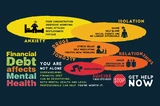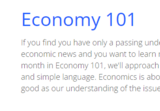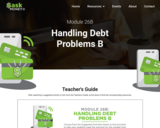
Forget the stigma and shame. Financial expert Bruce Sellery helps you understand bankruptcy and how to decide whether it's the right decision for your family...
- Subject:
- Business
- Financial Literacy
- Material Type:
- Activity/Lab
- Date Added:
- 02/26/2024

Forget the stigma and shame. Financial expert Bruce Sellery helps you understand bankruptcy and how to decide whether it's the right decision for your family...

The material in this lesson will help students become aware of the warning signs of financial difficulties. When difficulties arise, students should first contact their creditors. Next, efforts should be made to revise spending patterns. In addition, assistance from a Credit Counseling service agencies might be considered. What if these actions do not help?

This collection features resources to support teaching Module 26B: Handling Debt Problems B from the Saskatchewan Financial Literacy curriculum. This activity suggests articles, websites, assignments, and discussion topics to help develop some problem-solving skills in relation to managing debt problems.

Broke is a documentary about sports stars who went from having millions of dollars to being broke and the mental anguish that comes along with this. The movie explores why this happens, mostly due to how many of the individuals lacked basic financial literacy skills. Students will develop 5 lessons / take-aways that they learned from the movie that the rest of us can learn from? They will discuss the themes and lessons shared regarding making responsible financial decisions, ways to gather information and explore how financial security (or lack of it) can have a major influence on mental health and well-being.

There are several interesting articles written by Anne Gaviola on Vice focused on Canadian finances, debt, and correlations between money and a person’s well-being. Keeping your debt a secret can mess with your mind and body. The culture of secrecy around debt causes young people to suffer in silence, making it even harder to manage debt. Use this content for case-based learning opportunities.

In this Case Study, students will take on the role of a credit counselor to assist a borrower who finds himself in serious financial distress. Several options will be presented, and students will identify pros and cons of each approach and choose a path forward.

Managing debt loads can be very difficult and overwhelming at times. Hiding from debt and avoiding the problem, will only make the situation worse. This activity includes mini case studies on how to handle various debt problems so that the students can take control of their debt and move forward to a better financial future.

Students will learn the consequences of not paying one’s debts and the choices of last resort for out-of-control debt. Students will explain how using [types of predatory loans] can cause a vicious cycle of debt. Bankruptcy is also introduced, and the various costs associated with bankruptcy are outlined. The students will discover what steps a person can take to avoid filing for bankruptcy, including seeing a credit counselor.

This activity allows the students to discuss the burden of student loans and financing post-secondary education. An additional aspect to this activity is the mental health aspect regarding heavy debt loads for post-secondary. The discussion could include a debate on student loans, who is responsible and can a student "walk away" from this debt? Should the government pay for post-secondary education for everyone? If yes, would you be willing to pay more taxes for free post-secondary education?Students often finance their post-secondary education, which can be very expensive over many years. How does a student pay this debt back if they are unable to finish their program, especially in expensive programs such as medicine or law?

If you find you have only a passing understanding of the daily barrage of economic news and you want to learn more, you're in the right place. Each month in Economy 101, we'll approach a different aspect of the economy in clear and simple language. Economics is about choices, and our choices are only as good as our understanding of the issues.

This 4-minute video lesson explains the mechanics of a share-based acquisition. [Core Finance playlist: Lesson 144 of 184]

This 14-minute video lesson looks at Chapter 11: Restructuring through a bankruptcy. [Core Finance playlist: Lesson 23 of 184]

This 11-minute video lesson provides an introduction to bankruptcy liquidation (Chapter 7). [Core Finance playlist: Lesson 22 of 184]

This 3-minute video lesson explains the basics of deflation. [Core Finance playlist: Lesson 168 of 184]

This 5-minute video lesson looks at why Warren Buffett called Credit Default Swaps financial weapons of mass destruction. [Core Finance playlist: Lesson 167 of 184]

This 10-minute video lesson introduces balance sheets by looking at a home purchase to illustrate assets, liabilities and owner's equity. [Core Finance playlist: Lesson 7 of 184]

This 10-minute video lesson discusses the basics of mutual funds. [Core Finance playlist: Lesson 175 of 184]

This 13-minute video lesson looks at Chapter 7 and Chapter 13 personal bankruptcy. This video was sponsored by Visa, but Kahn had complete editorial freedom as to its contents.[Core Finance playlist: Lesson 50 of 184]

This 10-minute video lesson discusses how the unemployment rate is calculated. [Core Finance playlist: Lesson 176 of 184]

Examine the processes of and alternatives to personal bankruptcy in Saskatchewan.
Teacher Guide included.
3-5 hours